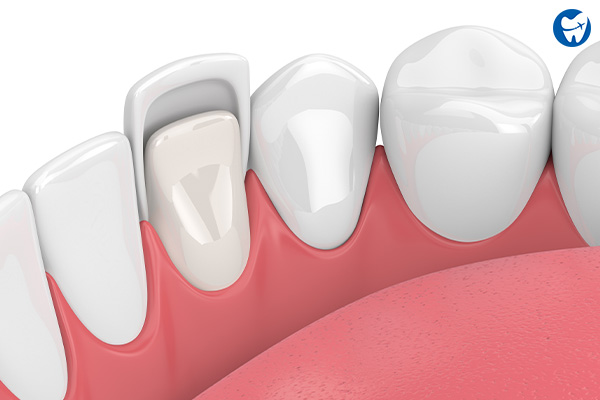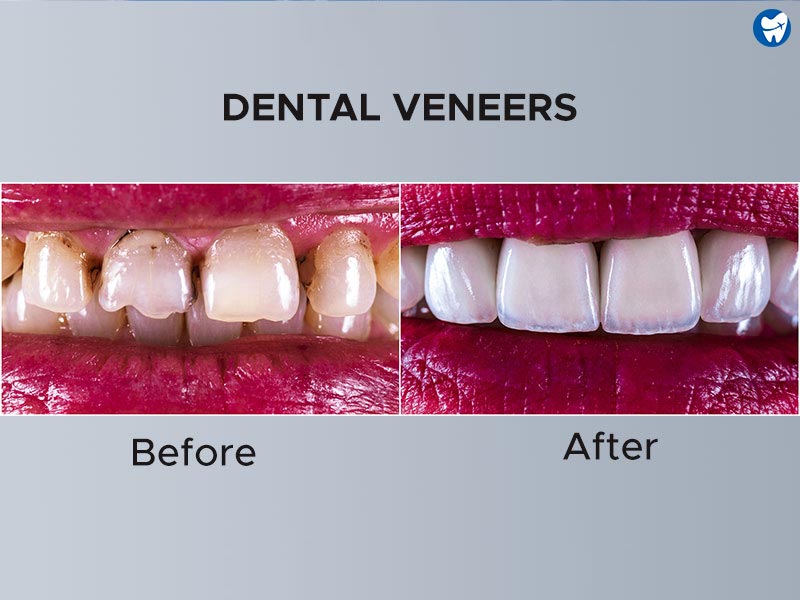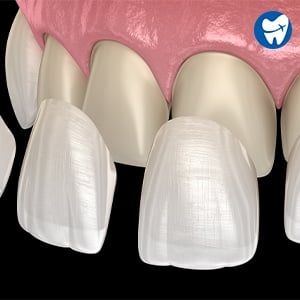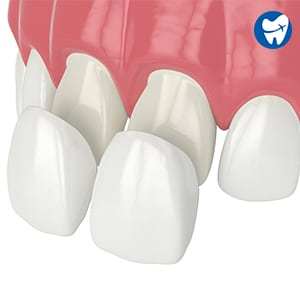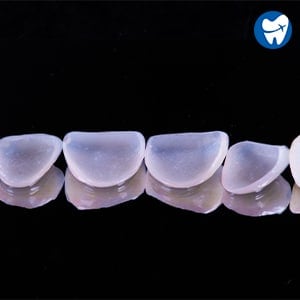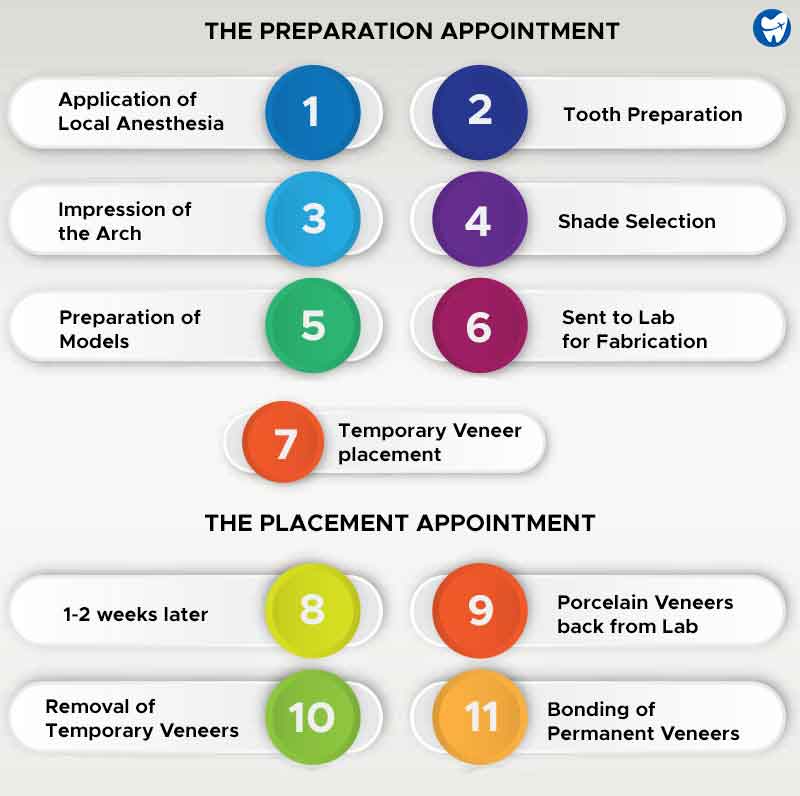Dental veneers are thin, tooth-colored shells used to cover the front surface of teeth to enhance their appearance. If you are looking for a “Hollywood Smile” they are one of the best ways to achieve a complete smile makeover.
Check out this expert guide to know all about the types, procedure, pros & cons, aftercare and the cost breakdown.
A comprehensive guide to dental veneers
What are Dental Veneers?
A dental veneer is a cosmetic restoration that is used to enhance the appearance of your smile.
Unlike fillings that go inside cavities or crowns that go around broken teeth, veneers are bonded to the front of healthy teeth.
As a result, they change how the tooth looks rather than repairing any damage.
However, sometimes they are also used to repair minor fractures in esthetic areas.
Most smile makeover clients get enough dental veneers to cover all visible teeth in their “smile zone.”
- Typically, it’s about 6-8 permanent veneers across their upper front teeth.
- It’s less common to need veneers on your lower teeth, as those are not as noticeable when you’re talking or smiling.
Dental veneers
However, the overall width of your smile is a significant factor in how many veneers you need.
Each care plan is specially tailored to your unique preferences and budget.
Am I a Candidate for Dental Veneers?
The ideal candidate for permanent veneers will be people with healthy teeth and gums who want to improve their smiles.
However, some cosmetic issues tend to be a bit much for simple whitening, bonding, or if you don’t want to wait months of orthodontic treatment.
Since dental veneers are custom-designed, dentists use them to correct your cosmetic concerns like:
- Crooked teeth
- Small gaps in your smile
- Slightly or chipped tooth
- Irregularly shaped teeth
- Staining & discoloration
- Smaller than average teeth
Not everyone is a candidate for dental veneers. Types and uses for veneers are restricted to adults with healthy teeth and gums.
They cannot be placed on:
- Children & young teens (whose mouths are still developing)
- Individuals with active gum disease
- Decayed teeth
Dental Veneers: Before & After
What Are the Types of Dental Veneers?
With various veneer designs available, you can select multiple materials or levels of veneers to fit your lifestyle.
Porcelain veneer cost tends to be higher, as they offer the best aesthetics and most lifelike color.
In comparison, composite resin veneers are the cheapest treatment if you only need to address one or two teeth.
Depending on what you’re hoping to achieve with your cosmetic treatment, you can choose from the common types of veneer varieties.
Porcelain Veneers
Porcelain veneers offer a premier level of dental aesthetics.
If you’re searching for that “go big or go home” smile makeover, traditional veneers are your answer.
These restorations involve:
- Prepping your teeth
- Taking a series of impressions
- Handcrafting the veneers
- Bonding them into place
Typically, the process requires two appointments about two weeks apart from start to finish.
Traditional Porcelain Veneers
They are the most attractive and durable of all modern dental veneer designs.
Composite Resin Veneers
These they are also called “chairside” or “same-day” veneers.
They’re made from the same type of material as white fillings and work well for correcting the appearance of 1-2 teeth.
Since your dentist handcrafts the composite, there’s no separate lab work.
During the placement:
- Your tooth is gently prepped
- The material is shaped into place
- Further, a bright light cures it permanently to the tooth
Composite Resin Veneers
Although resin is more affordable, it is not as durable as porcelain. [1]
Resin is also more prone to stain over time, hence they need to be updated frequently. [2]
Lumineers (No-Prep Veneers)
For patients who prefer a reversible dental veneer, no-prep designs [3] provide more freedom.
They are an ideal choice if:
- You don’t want them on forever
- Or you want to avoid enamel reduction
Lumineers are the most popular type of no-prep veneer on the market.
They provide better durability than composite veneers but are a bit more price-savvy than porcelain.
Lumineers (No-Prep Veneers)
However, it’s essential to keep in mind that not everyone qualifies for no-prep veneers, as bonding a restoration over some teeth could result in excess bulkiness & bite problems.
How Much Do Dental Veneers Cost?
On average, the cost ranges from $250 to $2500 per tooth, depending on the type of veneer you choose.
Composite resin veneers cost, on average, between $250 to $1500 per tooth.
Whereas traditional porcelain veneers typically range between $925 and $2500 per tooth.
Furthermore, no-prep veneers price is a bit higher, averaging $800 to $2000 per tooth.
| Type | Average Price Without Insurance (USA) |
|---|---|
| Composite veneers | $250 to $1500 |
| No-prep veneers | $800 to $2000 |
| Porcelain veneers | $925 and $2500 |
One of the biggest influencers on veneers price is where your dentist is located.
Since living costs impact everything from operating expenses, staff salaries to rent and supplies, dental treatment costs vary significantly in each area.
Another pressing question now arises: Does insurance covers veneers?
They are considered to be a cosmetic procedure by insurance companies. Hence are not covered by dental insurance plans.
In that case, you can save thousands of dollars on treatment. Getting low-cost dental veneers abroad becomes a great option in that case.
Get latest prices
Request nowPreparation for Your Appointment
- First, schedule a consultation and plan a visit with your cosmetic dentist.
- You can discuss what you want to change about your smile during this appointment, such as uneven, crooked, or stained teeth.
- Your dentist will need to complete a comprehensive exam, including taking necessary X-rays to screen for infection and disease.
- Moreover, he determines if the tooth structure is sound enough. Veneers can only be placed on healthy teeth, so this step is essential.
- You and your dentist will discuss what you want your new veneers to look like.
- Once you’ve settled on a final design, your dentist will book you for the preparation appointment.
How are Veneers Put on Teeth?
Traditional porcelain veneers are placed in two stages: the preparation appointment and the final placement.
This visit is the most detailed of your treatment. It involves several highly critical steps:
- Applying local anesthesia to numb your teeth
- Gently reducing the thickness of each tooth
- Taking a series of impressions
- Selecting the veneer shade (similar to the natural tooth)
- Pouring models of your teeth to send to the lab
- Writing up lab instructions on the precise color, shape, and size of each tooth
- Placing temporary veneers over your teeth to minimize sensitivity as you wait for the permanent ones to be handcrafted in the lab
About 1-2 weeks later, your porcelain veneers will be back from the lab and ready to affix into place.
A local anesthetic is not necessary.
Your temporary veneers are gently removed, and each of the corresponding permanent veneers is carefully bonded into place.
Dental Veneers Procedure
What Are the Pros & Cons of Dental Veneers?
Veneers provide optimal results for areas where bonding or whitening might not be effective. Plus, the results are quicker than braces.
Moreover, they only require a couple of appointments to complete; they offer the fastest smile makeover option for today’s patients.
At the same time, it’s important to realize the limitations of veneers.
The type of material your veneers are made from will also impact the overall aesthetic results.
Here is a list of pros and cons to help you understand them in-depth:
👍 Pros
Excellent Esthetics: Porcelain is more translucent, making it more attractive. When you apply them across several teeth, it gives off a much more natural hue and color. [4]
Durable: Permanent veneers made out of porcelain are durable and long-lasting. [5]
Faster Results: Although the process is more time-consuming, they still provide faster results than you would get from braces or Invisalign.
👎 Cons
Prone to chipping: They are not invincible to teeth clenching and grinding. If you tend to grind your teeth, sleeping in a nightguard can safeguard them.
Extensive process: They require two phases, prepping and placement, with about a 10-14 day break.
Costly: The cost of veneers may be one of the biggest disadvantages because these elective treatments are not covered by dental insurance.
👍 Pros
Cheaper: Resin is more affordable compared to porcelain.
Fast Results: They can be completed in one appointment, giving you quick results.
👎 Cons
Opaque: Resin is more opaque. When placed across several teeth, the opaqueness and lack of color differentiation makes your smile seem odd-looking or fake.
Fragile: They are much more fragile and prone to chipping from everyday wear; they are not recommended if you are prone to worn, flattened enamel. [6]
Protecting Your Investment: How to Take Care of Your Veneers?
The best way to get the most out of your cosmetic investment is to properly care for your dental veneers.
- Wear a nightguard while you sleep to avoid chipping or wear.
- Daily flossing is essential and will not pull your veneers off of your teeth.
- It’s important to clean around the edges of each veneer daily so that cavities don’t develop.
- If flossing is a bit of a challenge, consider using a water flosser instead.
- Use a soft or extra-soft toothbrush to clean your teeth daily.
- Avoid abrasives or harsh toothpaste containing baking soda.
- Avoid biting into hard objects or chewing on things, such as ice, pencils, fingernails, etc.
- Do not open packaging with your teeth.
- Pay attention to the health of your surrounding gum tissues.
- Wear an athletic mouthguard during sporting activities.
- Additionally, be sure to see your dentist every six months for ongoing preventative care and exams.
A Quick Solution for Your Smile
Dental veneers provide one of the most comprehensive, attractive solutions for modern smile makeover treatments.
When you’re looking for a “Hollywood smile,” the various dental veneer types and uses available can make your vision a reality.
After masking the natural teeth behind them, veneers provide an instantly straighter, whiter smile that you’ll feel proud of showing off around other people.
FAQs
Veneers are cosmetic dental restorations bonded over the front of individual teeth to change their look.
Unlike crowns, veneers only cover one surface instead of the entire tooth.
They correct the appearance of teeth that are crooked, gapped, stained, or misshaped.
Depending on the type of veneer you select, you may find yourself investing anywhere between $250 to $2500 per tooth.
Their cost is determined by how many veneers you need and the type of veneers.
For instance, full mouth veneers cost more in most cases, whereas individual composite resin veneers cost less.
Moreover, porcelain veneer cost tends to be much more than that of composite.
The short answer is yes!
Although the types and uses will vary, some are considered permanent while others are not. Any time the tooth is trimmed, the treatment is considered to be permanent.
If a veneer breaks or cracks, it must be replaced as soon as possible.
Porcelain veneers last the longest, whereas composite resin veneers may only last a few years. If you prefer something reversible, you can get no-prep veneers.
Veneers’ price is dependent upon the way they are made. For example, porcelain veneer cost is higher because of the detailed handcrafting.
That’s why full-mouth veneers cost more than one or two composite veneers.
When you’re transforming your entire smile, you need to have durable materials that withstand everyday activities.
A single composite veneer is appropriate if only one tooth is causing a problem. Much of the cost depends on your dentist’s location.
You should not expect any problems as long as you select durable veneers and care for them properly.
Although veneers don’t get cavities, the tooth around and behind them is still susceptible to bacteria. Hence, daily brushing, flossing, and regular checkups are essential.
Sleeping in a nightguard prevents unwanted chipping or fractures of your new veneers.
Resin veneers tend to cause more problems than porcelain veneers because they can collect stains and are prone to chipping over time.
Most dental veneers require removing a thin layer of enamel to create space for the veneer (so that your smile doesn’t look bulky).
Unfortunately, this is a non-reversible process.
This means that if you decide to remove your veneers or they break off, the tooth will need a new restoration.
No-prep veneers, such as Lumineers, require zero enamel alteration and are entirely reversible.
However, traditional veneers are a lifelong investment, so it’s essential to select a design that you feel comfortable with.
Composite veneers are the cheapest veneers. Their cost ranges from $250 to $1500 per tooth.
However, they are not appropriate for full-mouth smile makeovers.
Although composite resin is the cheapest veneer, it’s more brittle and can easily break or stain over time.
The most affordable veneers are composite resin.
However, alternatives can offset veneer costs, such as straightening your smile with braces and whitening your teeth professionally.
Bonding is another alternative, which only covers a portion of your tooth instead of the entire visible surface.
But depending on the type of treatment you’re getting, combining services like whitening, braces, and bonding may cost the same as dental veneers.
